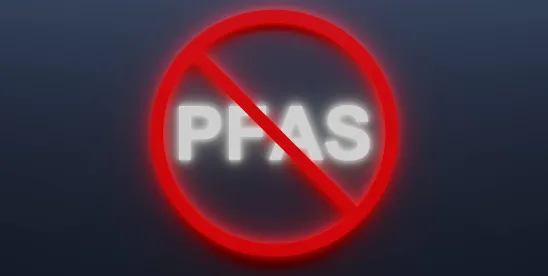Per- and polyfluoroalkyl substances (PFAS) are a class of thousands of human-made chemicals used across a number of industries. Their durability makes them ideal for various uses like stain protection in textiles, machine lubricants, and fire suppression. That same durability has led to their more common name, forever chemicals, as they do not break down easily in the environment and can persist in the human body for long periods. PFAS have been associated with an increased risk of certain cancers, hormone disruption, reproductive harm, and abnormal fetal development but the science is severely limited. The slow pace of study has made enforcement of rules regarding PFAS inconsistent (and the subject of legal challenges) and has caused a substantial amount of confusion and uncertainty among industry, municipalities, and consumers.
The two most studied PFAS, perfluorooctonesulfonate (PFOS) and perfluorooctanoic acid (PFOA), are now subject to federal and state drinking water maximum contaminant levels (MCLs) but the landscape is frequently shifting as the winds of politics blow and our understanding of this class of chemicals grows. The United States Environmental Protection Agency’s (USEPA’s) current Administrator, Lee Zeldin, made PFAS a clear priority and has acted quickly to make his mark on the regulatory landscape. While we have gained some regulatory clarity regarding PFAS, uncertainty still rules the day and will continue to frustrate decisionmakers for the foreseeable future. Municipalities, in particular, will be burdened with significant costs and potential liabilities as our state and federal governments continue developing the PFAS regulatory scheme.
The particular pain visited upon municipalities
Drinking water standards now exist and seem only to be getting more stringent as the science develops. The Wisconsin Department of Natural Resources (WDNR) and USEPA tend to give local governments considerable leeway, but the push to address PFAS is considerable and the need to protect drinking water is monumental. It’s only a matter of time before municipalities start being put on compliance schedules and potentially penalized for failing to act or to act timely. PFAS presents confusion across the board, but it will be felt most acutely by municipalities charged with providing safe drinking water to their communities.
What can Wisconsin municipalities do now to begin planning for compliance requirements?
Get a clear picture of the PFAS status in their water systems by conducting PFAS-specific sampling. Next, conduct a full top-to-bottom diagnosis of the technological shortcomings of the water treatment systems to identify where the current system falls short of meeting the oncoming standards. Next, assess system upgrades and identify revenue sources for these upgrades. There may be state and federal financial assistance available to help with those upgrades. Finally, make sure to assess whether any class action settlement resources are being maximized. But don’t ignore this problem and hope it goes away. If it feels like too high a hill to climb, then strategize with your team, consultants, and attorneys to identify the best path forward to safeguard your constituents and your resources.
The particular pain visited upon manufacturers and importers
Hazardous substance law—particularly the Superfund law—tends to be objectively unfair to manufacturers and importers as it can place strict and retroactive liability on parties guilty of simply producing goods with certain constituents at a time when no one knew those constituents posed any risks. Furthermore, the strict and joint and several liability schemes of most hazardous substance laws essentially shift the burden of proof to potentially responsible parties making them either prove they had no part in the contamination or their part was minimal enough to be let off the hook. As PFAS regulations continue to be developed, manufacturers and importers need to be prepared to defend themselves in lengthy and costly battles with state and federal authorities and among their peers in contribution actions. It is abundantly clear that PFAS liability is not going away and all parties would do well to gird themselves against unexpected consequences of the regulatory landscape by not only preparing the reports detailed below, if required, but by reviewing company, property, and other historical records for potential PFAS liability. Just like municipalities, industry would do well to strategize with their team, consultants, and attorneys to identify the best path forward to minimize risk and limit liability.
Status of PFAS in Wisconsin
In Wisconsin, PFOS and PFOA are subject to a 70 parts per trillion standard for drinking water. This might seem like a fairly low maximum, but it is far more liberal than the federal 4 parts per trillion standard. Now that the USEPA has established a limit of 4 parts per trillion, Wisconsin must change its enforcement standard to align with federal standards, as required by the Safe Drinking Water Act. The DNR is working to implement the federal standard, but rulemaking is a slow process. Our governments are working as fast as the bureaucracy allows to provide clarity and consistency.
Wisconsin has primary enforcement authority under most Clean Water Act programs, including our Wisconsin Pollutant Discharge Elimination System (WPDES). Facilities discharging to surface water or groundwater in Wisconsin need a permit to do so, and those permits are reviewed and granted by WDNR, subject to USEPA review and possible veto. The WDNR is still in the early stages of permitting PFAS discharges but it has promulgated a surface water quality standard. The application of that standard is complex and includes a measured rollout to minimize unnecessary and heavy-handed enforcement actions. The initial phase of that rollout is a permit requirement to monitor PFOS and PFOA effluent in select new and modified WPDES permits. If a discharge causes or contributes to an exceedance of a PFAS surface water quality standard, the permittee will be put on a pollution minimization plan typically requiring substantial investment in new technology. WPDES permittees or hopeful permittees should be thinking about PFAS now as their permit or renewal applications will require a consideration of PFAS in discharges.
As of now, however, Wisconsin has not promulgated groundwater standards—despite groundwater contamination being one of the main drivers for WDNR decisions whether to issue a “No Further Action” Letter to close a cleanup action. Property owners need to start preparing for the day groundwater standards are established by considering and implementing risk mitigation strategies now such as conducting groundwater testing to determine the extent of their potential risk and proactively addressing contamination where feasible.
Status of PFAS in Surrounding States
Minnesota
Minnesota has been executing its PFAS Blueprint since 2020, beginning with prohibiting PFAS-laden firefighting foam in testing or training, then prohibiting intentionally added PFAS in 11 categories of products, and soon with reporting requirements for manufacturers selling products containing intentionally added PFAS. Minnesota’s PFAS Blueprint will continue to be rolled out through 2032. The January 2026 reporting requirements introduce a new heavy burden on manufacturers selling products in Minnesota. Manufacturers failing to submit a timely report would be barred from selling products in Minnesota until the report is submitted. Defined “covered manufacturers” would do well to prepare for those requirements now before they are prohibited from selling products in Minnesota until the report is submitted.
Illinois
On March 25, 2025, Governor J.B. Pritzker signed a law which requires the Illinois Pollution Control Board to adopt rules to establish PFAS drinking water standards “identical in substance” to the USEPA standards. Municipalities and manufacturers alike should be aware of these oncoming standards and keep an eye on the rulemaking process as we all learn what precisely “identical in substance” means. On April 11, 2025, Illinois also established groundwater quality standards for six PFAS (PFOA, PFOS, PFNA, PFHxS, PFNS, and GenX). Public water systems in Illinois should be aware of these new standards and any obligations they impose. Manufacturers should similarly be aware of these standards as they could trigger costly and burdensome groundwater cleanup requirements.
Michigan
Michigan established drinking water standards for public drinking water supplies in 2020. Those standards cover 7 PFAS (PFOA, PFOS, PFNA, PFHxA, PFHxS, PFBS, and GenX) and are subject to ongoing litigation. These standards, if allowed to stand by the Supreme Court of Michigan, would trigger a groundwater cleanup requirement that could burden numerous responsible manufacturers with costly cleanups.
USEPA Developments
TSCA Reporting
Under the federal Toxic Substances Control Act (TSCA), USEPA must promulgate a rule to require each person who manufactures or manufactured PFAS in any year since 2011 to report information regarding PFAS uses, production volumes, disposal, exposures, and hazards. In October 2023, USEPA promulgated that rule with an original reporting deadline of November 12, 2024, which was extended to July 2025. Last month, however, USEPA extended the reporting deadline once again. The reporting deadline is now October 13, 2026, with an alternate deadline of April 13, 2027, for small businesses reporting solely on PFAS articles imported. The delay gives manufacturers more time to review records and gather necessary data to meet reporting requirements.
Water Standards
A Biden-era rule set drinking water standards for six PFAS, including PFOA and PFOS. On May 14, 2025, USEPA Administrator Zeldin announced USEPA would be keeping the MCLs for PFOA and PFOS but would initiate rulemaking to repeal the MCLs for the four additional PFAS (PFHxS, PFNA, GenX, as well as the novel hazard index mixture of these three plus PFBS).
These changes are consistent with Administrator Zeldin’s emphasis on substantiated science and a desire to roll back what the administration views as regulatory overreach leftover from the Biden administration. As science continues studying this class of chemicals, we can expect to see new drinking water quality standards as well as the first enforceable standards under the National Pollutant Discharge Elimination System.
CERCLA and the Spill Law? Who knows.
The PFAS regulatory scheme under CERCLA and the Wisconsin Spill Law continues to be hard to pin down. PFOA and PFOS were designated hazardous substances by the Biden administration—a necessary definition under CERCLA, but as of this writing Administrator Zeldin has not signaled whether that designation will remain. It’s likely any movement on PFAS under CERCLA will wait until Congress has acted to limit liability for passive receivers of PFAS. Under CERCLA’s strict liability scheme, passive receivers of PFAS, like landfills and water utilities, would be on the hook for clean-up costs. Groups representing these entities have been lobbying Congress to carve out an exemption for years.
The status of PFAS under Wisconsin’s Spill Law is the subject of a much-anticipated Wisconsin Supreme Court decision. WDNR has long enforced the Spill Law with a novel approach, sometimes determining what is a “hazardous substance” under Wisconsin law essentially on a case-by-case basis. At issue before the Court is a March 6, 2024 decision by the Wisconsin Court of Appeals determining that DNR failed to follow proper rulemaking procedure when it decided to regulate PFAS as a hazardous substance. Should the Wisconsin Supreme Court affirm that decision, WDNR’s historic flexible use of the Spill Law would be neutered. However, if the Court reverses the decision we can expect to see more Spill Law actions undertaken to address PFAS contamination. The Wisconsin Supreme Court is expected to hand down that decision any day.




 />i
/>i

